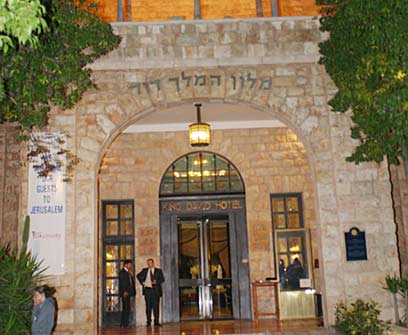
King David was born into splendor. Planned and built under the British rule, between 1929 and 1931, it was made to echo ancient royal palaces.

King David Hotel (Photo: Ata Awisat)
The original idea to build such a hotel in Jerusalem belongs to the Musari family of wealthy Egyptian Jews who decided Jerusalem needs a hotel that could cater to senior British officials and high generals, as well as the wealthy Jewish donors who visited the city. The family purchased an 18-dunam plot from the Scottish Church, on what then was known as Heretic Julian St, paying 31,000 Israeli liras.
Inspired by the ancient palaces, the hotel designers built cedar-like pillars, decorated cornices, and giant wooden doors. Wishing to meet the highest international standards, the owners spared no effort and expense importing, among other things, superb food by daily train from Cairo. They hired an international staff, with waiters from Egypt and Sudan, managers from Switzerland, and chefs from Italy.
Yet, with all their good intentions, reality was very tense and security problems chased away tourists during the fist decade of the King David existence. Business picked up only when the British Government established its quarters in the southern wing of the hotel, in the 1940's.
The prosperity was short lived as Jewish underground movements marked the hotel as the symbol of British occupation. On 22 July 1946, Irgun members entered the hotel dressed as Arab workers and planted milk containers filled with explosives in the restaurant on the bottom floor of that southern wing.
The Irgun warned the hotel management ahead of time, but they ignored the warning. At 12:30, the bombs exploded and ruined the five-story southern wing, built of massive Jerusalem rock, killing 91 (including 17 Jews), and wounding 476 people.
An "Exodus" scene
After the War of Independence, the building again functioned as a hotel and in 1958, the Federman brothers, owners of the Dan Hotel network, purchased it and made what was then viewed as a huge, USD two million investment.
They rebuilt the southern wing, installed an AC system, replaced the worn out canopy beds with precise replicas, and renewed the antique lobby furniture. After its grand reopening, King David has become the hotel of choice for the Israeli Government and visiting dignitaries.
In the 1960's, the owners wanted to build two more floors on the hotel building, but wishing to preserve its unique and original appearance, they needed stones from Hebron, that were unavailable.
Only after the Six-Days War were they able to solve this problem. After Jerusalem was reunited, the city and the King David enjoyed a massive tourism boost, in the wake of which the owners built a tennis court and a swimming pool, which became a highly coveted meeting spot for Jerusalem's high society.
In 1996, the hotel was rebuilt again, and the owners added a gym, restaurants, and large suits, which were created by eliminating smaller rooms. These are very elegant suites, complete with TV, video, and stereo sets, large marble baths, Jacuzzis, and double sinks.
The two-story presidential suite on the fifth floor is overlooking the Old City walls. It has a spacious living room with wooden floors on the top floor, and a large bedroom with its own double Jacuzzi, dry sauna, and massage shower on the lower floor, as well as a conference room, a dining room for 12, and another fancy bedroom.
Presently, the hotel offers 237 rooms and 37 suites of various sizes and designs. With its culinary selection, perfect service, wide selection of alcoholic beverages and wines, and gourmet dishes, the La Regence meat restaurant gained international reputation. The hotel also offers the King's Garden Dairy Restaurant, overlooking the walls. A scene from "Exodus," starring Paul Newman, was shot on its terrace.
Historic moments in exhibition
The King David staffers witnessed numerous historical and crucial moments in the history of the State of Israel. The sensational and exciting announcement that Sadat was coming to Jerusalem reached the staffers only 12 hours before the late Egyptian president set foot on the red carpet here. When he stayed here, between 19 and 22 November 1977, all the guests were transferred to other Israeli hotels.
The library table, a masterpiece on its own accord, served the Egyptian president at the time. It later starred in another historic event: On 26 October 1994, it was flown to the Arava Border Crossing, north of Elat, where Israel and Jordan signed their peace treaty on its top.
The hotel remembers sad moments too, such as the time it hosted world leaders who came to Yitzhak Rabin's funeral.
This year, the King David marks its 75th anniversary. In its honor, it will issue a medal and launch an exhibition of the hotel history in December. The exhibition will display pictures of scenes and moments that left their mark on the land and State of Israel, distributed all over the lobby and other public spaces.
Among other things, it will display photographs from the early 20th century, and portraits and signatures of dignitaries who stayed there over the years will be projected on the King David walls.















